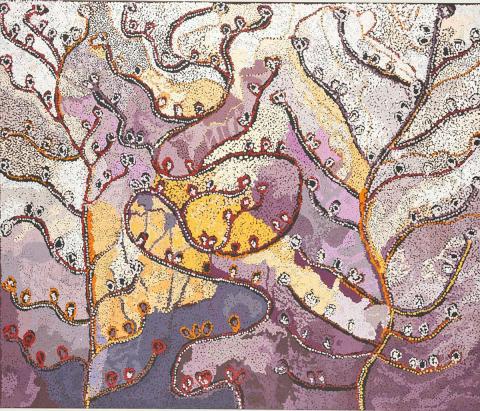ESSAY: Wawiriya BURTON and Nellie Ngampa COULTHARD
By Bruce Johnson McLean Katina Davidson
Artlines | 3-2019 | June 2019
Editor: Stephanie Kennard
Wawiriya Burton and Nellie Ngampa Coulthard, women of Australia’s central desert, are nationally significant contemporary painters whose colourful representations of their Country are shaping stylistic movements and traditions within their communities. Burton’s Ngayuku ngura – My Country 2018 and Coulthard’s Tjuntala Ngurangka (Country with Acacia Wattle) 2018 are part of a group of works acquired by QAGOMA from the 2018 Desert Mob Art Fair, held annually at Araluen Arts Centre in Alice Springs.
Wawiriya Burton is a senior Pitjantjatjara woman of law and culture and a revered Ngangkari (traditional healer). Born in 1925, Burton lives and works at Amata in the Anangu Pitjantjatjara Yankunytjatjara (APY) Lands of far north-western South Australia. During her childhood her family travelled across their country to the Warburton Mission in Western Australia, where she first recalls coming into contact with non-Indigenous people.1 Memories of her youth and stories of where she was born — on her father’s Country near Pipilyatjara in Western Australia, west of Amata — are often subjects of her work, which she paints in refined, complex depictions in brilliant colour. The minyma mingkiri tjuta (small female desert mice) found at important cultural sites are celebrated in Ngayuku ngura – My Country. The artist explains:
The mingkiri are pregnant and give birth to many babies. They then journey to the surrounding rock holes in search of food and water for their young. The dotted lines [in the work] are mingkiri tracks.2
At almost two metres square the work has a confident presence, which is enhanced by an evocative composition of dense colour fields that hum with energy. Ngayuku ngura is arguably her most painted and revered subject, and in this work her country appears as vast fields of dusty pink and eucalypt green, described by curator Diane Moon as ‘sage and silver contrasting with the rich, red colour of the earth’.3 The fields of colour bleed into each other in thickly clumped trails, reminiscent of the Amata landscape which is ‘dotted with round clumps of spinifex, sparse desert oaks and soft grasses’.4 These tracks, simultaneously macro and micro in their appearance, are of the earth, the mingkiri (mice), the flora and the Pitjantjatjara people.
Roughly 300km south-east of the APY Lands is the community of Indulkana, home to respected Yankuntjatjara painter and educator Nellie Ngampa Coulthard. Coulthard’s striking and idiosyncratic works are reminiscences of her childhood living on country around Wintinna Homestead near Oodnadatta, on the edge of the Simpson Desert.5 Coulthard was raised in a wiltja (tin-and-log shelter) in this area and lived a semi-traditional lifestyle while her father worked at the homestead for rations.
Coulthard paints the country in a mix of styles, combining traditional dotting techniques in whites and yellows — evoking the colours and heat haze of the desert sands — while dividing the painting with meandering lines, which in one orientation reveal the local acacia wattles that she vividly recalls seeing in flower as a child, their vibrant yellows piercing the hard country. In Tjuntala Ngurangka (Country with Acacia Wattle), Coulthard’s composition of wattle trees is also suggestive of the many creeks that flow through the area, feeding Lake Eyre some 200km away. This country is renowned for transforming during times of rain, and Coulthard’s paintings often exhibit a tonal shift from hot colours to cool, evocative of the transformations that the country periodically undergoes.
Expansive and personal, gestural and precise, these two vibrant recollections of Country have made a vital contribution to the Gallery’s Collection of desert women’s paintings.
Endnotes
- Tjala Arts (ed.), Nganampa Kampatjangka Unngu / Beneath the Canvas: The Lives and Stories of the Tjala Artists, Wakefield Press, Mile End, South Australia, 2015, p.140.
- Artist statement in Certificate of Authenticity provided by Tjala Art, 2017.
- Diane Moon, ‘Amata painters’, in Contemporary Australia: Women, QAGOMA, Brisbane, 2012, p.57.
- Moon, Contemporary Australia: Women, p.57.
- Nellie Coulthard quoted on Iwantja Arts, http://www.iwantjaarts.com.au/our-artists/nellie-coulthard, viewed June 2019.
Connected objects

Ngayuku ngura - My Country 2018
- MRS BURTON - Creator
Metadata, copyright and sharing information
About this story
- Subject
